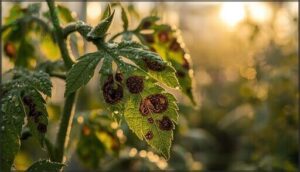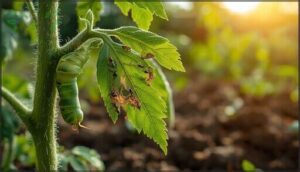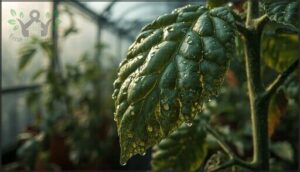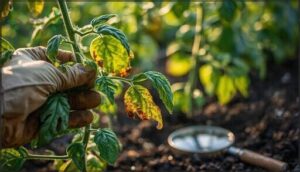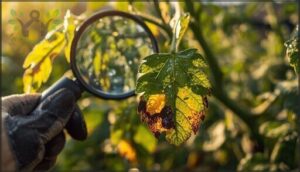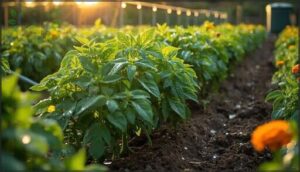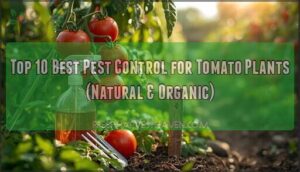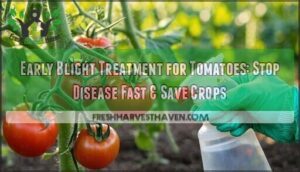This site is supported by our readers. We may earn a commission, at no cost to you, if you purchase through links.
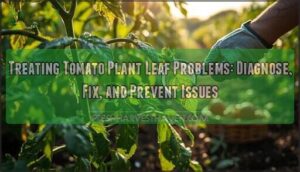
You’ve probably walked past your tomato plants dozens of times this season, watching them grow strong and healthy, only to notice one morning that the leaves don’t look quite right anymore. Yellow patches creep across the foliage, brown spots cluster near the veins, or the leaves curl inward like they’re protecting themselves from an invisible threat.
These warning signs aren’t just cosmetic issues—they’re your plants’ way of signaling that something has disrupted their growth, whether it’s a fungal infection taking hold, nutrient deficiencies in the soil, or pests making a meal of your future harvest.
The good news is that treating tomato plant leaf problems becomes straightforward once you understand what you’re looking at and why it’s happening. With the right diagnostic approach and targeted interventions, you can reverse most leaf issues before they compromise your entire crop.
Table Of Contents
Key Takeaways
- Tomato leaf problems—whether yellowing, spots, curling, or holes—signal specific issues like fungal infections, nutrient deficiencies, pests, or environmental stress, and early diagnosis through careful visual inspection is essential for effective treatment.
- Most fungal diseases (early blight, Septoria leaf spot) and bacterial infections spread rapidly in humid conditions, so removing infected leaves promptly, improving air circulation, and applying organic or chemical fungicides can stop the progression before it compromises your entire crop.
- Preventing future leaf problems requires a multi-layered approach: choose disease-resistant varieties, practice crop rotation, maintain proper watering and mulching techniques, and sanitize tools regularly to break disease cycles.
- Environmental stressors like overwatering, nutrient imbalances, and temperature fluctuations often mimic disease symptoms, so adjusting watering schedules, ensuring proper soil pH, and providing adequate spacing can resolve many issues without chemical intervention.
Common Tomato Leaf Problems
Tomato leaves can show all sorts of trouble, from yellowing to spots and curling. Knowing what to look for is the first step toward healthy plants.
Here are the most common leaf problems you might notice in your garden.
Yellowing Leaves
Why do yellowing leaves seem to haunt every tomato grower’s garden? Yellow leaves signal issues like nutrient deficiency, poor soil quality, or water management errors—not just natural leaf senescence.
For precise leaf problem diagnosis, check for:
- Nitrogen deficiency on older leaves
- Iron deficiency on new growth
- Overwatering symptoms
- Lack of disease resistance in your variety
Improper light conditions can also cause yellowing.
Brown or Black Spots
If you spot brown or black spots creeping across your tomato leaves, you’re likely dealing with fungal infections like Septoria leaf spot or early blight. Leaf spotting starts on older leaves and can spread fast, especially in humid conditions.
Black spot prevention hinges on prompt removal, organic remedies like copper sprays, and spot disease management—keep foliage dry and airflow steady. Understanding fungal disease causes is essential for effective prevention and treatment of these issues.
Leaf Curling and Wilting
When leaf curling and wilting show up in your tomato patch, it’s not always disease knocking at the door. Sometimes, Ethylene Exposure from heaters, Herbicide Drift, or a Nutent Imbalance can trigger these leaf problems. You might face:
- Sudden yellow leaf curl from whitefly activity
- Droopy stems after Soil Solarization
- Edges curling in hot, dry spells
- Wilting linked to watering mistakes
Holes and Chewing Damage
If you notice ragged holes or chewed edges after tackling leaf curl, think pests. Flea beetles, hornworms, and slugs are top suspects, each leaving distinct marks.
Assess leaf damage closely—shot holes, skeletonized veins, or missing chunks.
Effective pest control methods include organic pest management, insecticidal soap use, and physical removal, all critical for keeping infestations from snowballing.
Blistering or Puckering
Ever wondered why tomato leaves sometimes develop odd blisters or puckering? These symptoms point to Environmental Stress and Physiological Disorders like Leaf Edema or intumescence.
High humidity, low UV light, and excessive watering all drive Blister Formation. You’ll spot raised bumps without necrosis—unlike Leaf spot or Yellow leaf curl.
Intumescence Control means spacing out watering and boosting sunlight exposure.
Diagnosing Leaf Issues in Tomato Plants
Figuring out what’s wrong with your tomato leaves starts with spotting the right signs. You’ll need to look closely and notice how each problem shows up.
Let’s walk through the main ways to tell what’s happening with your plants.
Visual Identification of Symptoms
Think of your tomato plant as a living report card—every leaf tells a story. When you do a careful Plant Inspection, watch for these Symptom Patterns and Disease Signs:
Treat each tomato leaf like a report card—careful plant inspection reveals the symptom patterns and disease signs that tell your garden’s story
- Leaf Discoloration (yellow, brown, black)
- Leaf spots with distinct margins
- Wilting or curling edges
- Holes or chewing marks
- Blistering or puckering textures
Visual Diagnosis guides your next move.
Differentiating Between Diseases
How can you tell if a Tomato Leaf Problem is fungal, bacterial, or viral? Leaf Analysis is key—Fungal Diseases like early blight show brown lesions with rings, while Bacterial Identification relies on spotting water-soaked black spots. Viral Symptoms, such as curling and yellowing, often stunt growth.
Disease Patterns help guide Disease Identification, letting you target treatments for specific Disease Symptoms.
Recognizing Physiological Disorders
When Tomato Leaf Problems crop up, not every yellow or curled leaf signals disease—sometimes, it’s Physiological Disorders at play. Leaf Stress Symptoms like wilting leaves, yellowing, or puckering often stem from Nutrient Imbalance or Environmental Factors.
High heat, erratic watering, or Plant Hormone Regulation shifts can trigger these leaf problems, reducing yield and complicating diagnosis for even seasoned growers.
Spotting Pest Damage
Spotting pest damage is like reading a crime scene—leaf inspection reveals clues that guide your next move in pest management. Pests leave distinct marks you can’t ignore:
- Irregular blotch mines (pinworm)
- Sticky honeydew from aphid infestation
- Large chewed holes (hornworm)
- “Shot hole” patterns (flea beetle)
- Necrotic spots with yellow halos (stink bug)
Effective pest identification sharpens your garden pest control.
Causes of Tomato Leaf Diseases
Tomato leaf problems can come from several sources, and knowing what’s behind the symptoms makes all the difference. Some issues start with fungi, others with bacteria or viruses, and even the environment can play a role.
Here’s a look at what might be causing trouble for your plants.
Fungal Infections (Early Blight, Septoria, Fusarium)
Ever notice leaf spots marching up your tomato plants after humid weather? That’s the calling card of fungal disease—like early blight’s ringed lesions, Septoria leaf spot’s grey-centered specks, or Fusarium wilt’s yellowing and drooping.
Managing these infections means strategic crop management, timely fungicide application, and soil treatment. Disease-resistant varieties and careful watering can tip the scales in your favor.
Bacterial Diseases (Bacterial Wilt)
While fungal threats leave visible scars, bacterial wilt works quietly, turning lush leaves limp and green. This soil-borne menace spreads fast, especially in hot, moist conditions, and can wipe out entire crops if ignored.
Disease resistance matters here—varieties like ‘Invincible’ stand a better chance. Smart crop management and controlling bacterial spread are your best tools for tackling these tricky tomato diseases.
Viral Infections (Yellow Leaf Curl Virus)
If bacterial wilt leaves you guessing, yellow leaf curl virus makes itself known with twisted, yellowed foliage and stunted growth. The real culprit is the whitefly—spreading viral diseases of tomatoes like wildfire. For effective crop protection, focus on:
- Virus transmission blocking
- Whitefly control strategies
- Resistance breeding for tough plants
- Molecular diagnostics for early detection
- Managing mosaic virus symptoms
Environmental and Nutrient Stress
Whiteflies may spread viruses, but tomato leaf problems often stem from everyday stressors. Temperature fluctuations, nutrient deficiencies, and water stress effects can mimic disease—leaves curl, yellow, or wilt. Keeping soil pH management in check, adjusting watering, and watching sun exposure and soil drainage help you tackle abiotic factors head-on.
| Stress Type | Symptom | Solution |
|---|---|---|
| Water Stress | Leaf curling | Adjust watering |
| Nutrient Deficiency | Yellow leaves | Fertilize wisely |
| Sun Exposure | Leaf scorching | Provide shade |
Effective Treatments for Leaf Problems
Once you’ve spotted trouble on your tomato leaves, it’s time to act fast. There are several proven ways to tackle these issues and keep your plants healthy.
Here are the most effective treatments you can use right now.
Removing and Disposing Infected Leaves
Did you know that Leaf Removal Timing can make or break your fight against Tomato Leaf Problems? Prune infected leaves early in dry, sunny mornings using sanitary pruning methods—never during damp weather.
Dispose of leaves by burning or sealing them, not composting, to control fungal spores and prevent disease spread. This is important for managing Septoria leaf spot and powdery mildew.
Organic and Chemical Fungicides
When tackling fungal diseases of tomatoes, you’ll find both organic biofungicides and chemical fungicides at your disposal. Fungicide effectiveness depends on application practices and resistance management. Copper fungicide is widely used, but environmental impacts urge caution. Always rotate products for consumer safety and better results. Here’s what matters most:
- Product selection
- Proper dosing
- Timely application
- Rotation
- Environmental awareness
Home Remedies (e.g., Baking Soda Solution)
A gardener’s toolkit often includes Natural Fungicides like Baking Soda, prized for its role in Eco Friendly Solutions. When you mix a tablespoon with water, oil, and soap, you create an Organic Spray that suppresses Leaf Spot and Powdery Mildew.
Foliar Treatments work best early, targeting Fungal Diseases—not Bacterial Spot—offering a practical way to manage Tomato Leaf Problems.
Improving Air Circulation and Watering Practices
When you fine-tune Air circulation and Watering practices, your tomato care can turn the tide against leaf problems. Smart Gardening techniques—like these—make all the difference:
- Pruning Techniques to boost airflow and Disease Prevention
- Soil Aeration for healthy roots
- Adjusting Watering Frequency to match soil type
- Ventilation Methods that dry leaves fast and keep fungi at bay
Preventing Future Tomato Leaf Issues
Keeping tomato plants healthy takes more than quick fixes—it’s about smart planning and steady habits. If you want fewer leaf problems next season, a few key strategies can make a real difference.
Here’s what to focus on for lasting results.
Choosing Disease-Resistant Varieties
Ever wondered why some tomato plants thrive even in disease-heavy seasons? That’s the power of resistant variety selection and smart breeding techniques.
Choosing disease-resistant tomato varieties, like ‘Celebrity VFFNTA’ or ‘Plum Regal,’ weaves genetic resistance and hybrid development into your crop protection strategy, boosting plant health and disease tolerance, and streamlining disease management for reliable yields.
Crop Rotation and Soil Management
Did you know crop rotation is like resetting your soil’s immune system? By weaving in non-host crops, you boost soil health and release beneficial soil enzymes. Here’s how to strengthen your tomato crop protection:
- Rotate crops for disease suppression
- Use soil conservation techniques
- Balance nutrient management
- Monitor long-term challenges
- Cultivate thriving microbial communities
Mulching and Pruning Techniques
Think of mulching as a protective blanket and pruning as a sculptor’s touch—both are essential for top-tier tomato health. Mulch materials like compost or straw lock in soil temperature, suppress weeds, and feed your plants.
Pruning tools let you remove crowded or diseased leaves, boosting air circulation and reducing tomato leaf problems. Together, these practices strengthen your garden maintenance against plant diseases.
Sanitizing Tools and Garden Hygiene
After pruning and mulching, don’t overlook garden hygiene. Sanitizing tools—using bleach or Lysol—stops diseases cold. Removing plant debris and keeping pathways clear helps prevent fungal disease spread.
Mulching benefits extend to reducing soil splash, and watering at the base keeps leaves dry. Good air circulation, paired with routine tool disinfection methods, is your frontline for disease prevention.
Advanced Disease Detection Technologies
Beyond traditional methods, new AI diagnostics and sensor networks now detect tomato leaf problems days before disease symptoms and signs appear. Hyperspectral imaging and robotic platforms achieve over 97% accuracy in disease identification, while model interpretability tools explain each diagnosis.
These advances in plant disease management transform how you monitor crops, catching early blight or fungal infections when treatment works best.
Frequently Asked Questions (FAQs)
Can overwatering cause tomato leaf problems?
Yes, overwatering causes serious tomato leaf problems. You’ll notice yellowing leaves starting at the bottom, downward leaf curling, wilting despite wet soil, and increased fungal diseases like early blight due to oxygen-starved roots.
When should I start treating infected plants?
Timing is everything when disease strikes. Start treating your tomatoes the moment you spot the first symptom—waiting even 72 hours can increase infection severity by 35–80%, so immediate action saves your crop.
Are tomato leaf problems contagious to other plants?
Most tomato leaf problems spread through insect vectors, contaminated tools, or water splash.
Viral transmission, bacterial contagion, and fungal diseases like Septoria leaf spot can infect nearby susceptible plants through these pathways.
How do I restore severely damaged tomato plants?
Splinting broken stems with bamboo and tape facilitates stem regeneration within 10 days.
Apply fungicides for soil remediation, remove damaged foliage strategically for plant rejuvenation, and address fungal diseases causing leaf spot and wilting immediately.
What nutrients prevent common tomato leaf diseases?
Balanced fertilization with nitrogen, phosphorus, and potassium strengthens tomato leaf defenses against pathogens. Calcium supplements and micronutrient balance prevent deficiencies that weaken plants.
Proper soil management and nutrient delivery are essential for disease resistance.
Conclusion
Even when damage seems extensive, most tomato plants can bounce back faster than you’d expect with prompt intervention. Treating tomato plant leaf problems doesn’t require perfect conditions or expensive products—just consistent observation and timely action.
Check your plants every few days, remove affected foliage before issues spread, and adjust your care routine based on what the leaves tell you. Your garden’s success depends on reading these early warnings correctly.
- https://extension.umd.edu/resource/fusarium-wilt-tomatoes-home-garden/
- https://extension.umn.edu/planting-and-growing-guides/solarization-occultation
- https://apps.extension.umn.edu/garden/diagnose/plant/vegetable/tomato/leaveschewed.html
- https://www.corrys.com/resources/what-pest-is-eating-holes-in-my-plant-leaves
- https://www.tandfonline.com/doi/full/10.1080/09670874.2023.2252760


